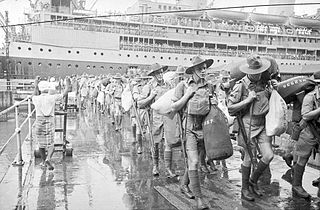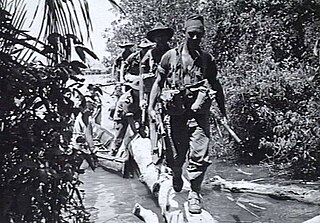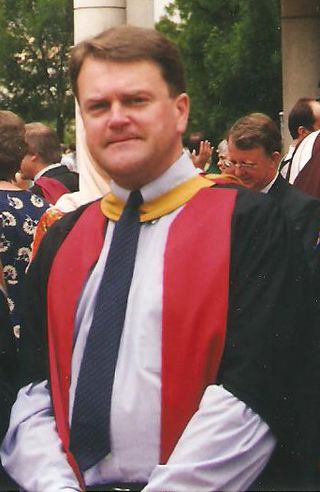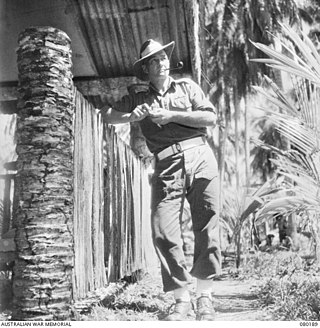Related Research Articles

The 8th Division was an infantry division of the Australian Army, formed during World War II as part of the all-volunteer Second Australian Imperial Force. The 8th Division was raised from volunteers for overseas service from July 1940 onwards. Consisting of three infantry brigades, the intention had been to deploy the division to the Middle East to join the other Australian divisions, but as war with Japan loomed in 1941, the division was divided into four separate forces, which were deployed in different parts of the Asia-Pacific region. All of these formations were destroyed as fighting forces by the end of February 1942 during the fighting for Singapore, and in Rabaul, Ambon, and Timor. Most members of the division became prisoners of war, waiting until the war ended in late 1945 to be liberated. One in three died in captivity.

The Borneo campaign or Second Battle of Borneo was the last major Allied campaign in the South West Pacific Area during World War II to liberate Japanese-held British Borneo and Dutch Borneo. Designated collectively as Operation Oboe, a series of amphibious assaults between 1 May and 21 July 1945 were conducted by the Australian I Corps, under Lieutenant-General Leslie Morshead, against Imperial Japanese forces who had been occupying the island since late 1941 – early 1942. The main Japanese formation on the island was the Thirty-Seventh Army under Lieutenant-General Masao Baba, while the naval garrison was commanded by Vice-Admiral Michiaki Kamada. The Australian ground forces were supported by US and other Allied air and naval forces, with the US providing the bulk of the shipping and logistic support necessary to conduct the operation. The campaign was initially planned to involve six stages, but eventually landings were undertaken at four locations: Tarakan, Labuan, North Borneo and Balikpapan. Guerilla operations were also carried out by Dayak tribesmen and small numbers of Allied personnel in the interior of the island. While major combat operations were concluded by mid-July, localised fighting continued throughout Borneo until the end of the war in August. Initially intended to secure vital airfields and port facilities to support future operations, preparatory bombardment resulted in heavy damage to the island's infrastructure, including its oil production facilities. As a result, the strategic benefits the Allies gained from the campaign were negligible.

The Battle of Balikpapan was the concluding stage of Operation Oboe, the campaign to liberate Japanese-held British and Dutch Borneo. The landings took place on 1 July 1945. The Australian 7th Division, composed of the 18th, 21st and 25th Infantry Brigades, with a small number of Netherlands East Indies KNIL troops, made an amphibious landing, codenamed Operation Oboe Two, a few miles north of Balikpapan. The Allied invasion fleet consisted of around 100 ships. The landing had been preceded by heavy bombing and shelling by Australian and US air and naval forces. The Allied force totalled 33,000 personnel and was commanded by Major General Edward Milford, while the Japanese force, commanded by Rear Admiral Michiaki Kamada, numbered between 8,400 and 10,000, of which between 3,100 and 3,900 were combatants. After the initial landing, the Allies secured the town and its port, and then advanced along the coast and into the hinterland, capturing the two Japanese airfields. Major combat operations concluded around 21 July, but were followed by mopping-up operations, which lasted until the end of the war in mid-August. Australian troops remained in the area until early 1946.

The Battle of North Borneo took place during the Second World War between Allied and Japanese forces. Part of the wider Borneo campaign of the Pacific War, it was fought between 10 June and 15 August 1945 in North Borneo. The battle involved a series of amphibious landings by Australian forces on various points on the mainland around Brunei Bay and upon islands situated around the bay. Japanese opposition to the landings was sporadic initially, although as the campaign progressed a number of considerable clashes occurred and both sides suffered significant casualties, although major combat was largely restricted to Labuan and around Beaufort. On the mainland, while Allied conventional operations focused largely on the coastal areas around Brunei Bay, guerrilla forces consisting of Dayak tribesmen and small numbers of Allied personnel from the Services Reconnaissance Department fought an unconventional campaign in the interior. The Allies were successful in seizing control of the region. Nevertheless, many of the strategic gains that possession of North Borneo provided were ultimately negated by the sudden conclusion of the war in August 1945.
David Murray Horner, is an Australian military historian and academic.

The 2/16th Battalion was an infantry battalion of the Australian Army, serving during World War II. Attached to the 21st Brigade that was assigned to the 7th Division, the 2/16th was raised in 1940 as part of the Second Australian Imperial Force from volunteers drawn mainly from the state of Western Australia. After training in Australia, the battalion was deployed to the Middle East where it undertook defensive duties along the Egyptian–Libyan border in early 1941 before taking part in the Syria–Lebanon campaign, fighting against Vichy French forces in June and July. At the conclusion of the campaign, the 2/16th remained in Lebanon, contributing to the Allied occupation force there, before returning to Australia in early 1942 following Japan's entry into the war. In August 1942, they were committed to the fighting along the Kokoda Track and then later fought around Buna and Gona. After a period of rest and reorganisation in Australia, the battalion fought around Lae and then took part in the Finisterre Range campaign in 1943–44. Its final campaign of the war came in Borneo in July 1945. At the end of the war, the 2/16th were disbanded in January 1946.

The 2/40th Battalion was an infantry battalion of the Australian Army. Formed in mid-1940 from personnel recruited from Tasmania, the battalion was assigned to the 23rd Brigade, which formed part of the 8th Division. After completing basic training, the 2/40th was sent to Darwin to form part of the defensive garrison there as tensions with the Japanese grew throughout 1941. Following Japan's entry into the war, the battalion was deployed to Timor as part of Sparrow Force and in early 1942 they took part in the fighting on the island against the Japanese. Outnumbered and lacking supplies, the majority of the 2/40th's personnel were captured and spent the rest of the war as prisoners of war, although some were able to wage a guerrilla campaign across the island before being withdrawn by the end of year.

The Official History of Australian Peacekeeping, Humanitarian and Post-Cold War Operations is the official history of Australia's military and civilian involvement in peacekeeping since 1947 as well as military operations in the years after the end of the Cold War. The series, comprising six volumes, was jointly produced by the Australian War Memorial and Australian National University, with Professor David Horner serving as its general editor.

The 2/19th Battalion was an infantry battalion of the Australian Army, which was raised for service during the Second World War as part of the Second Australian Imperial Force. After being formed in mid-1940, the battalion was allocated to the 22nd Brigade, which was part of the 8th Division. After completing training in Australia, in early 1941 the 2/19th deployed to Malaya, as part of the Australian force despatched to help bolster the British garrison there as tensions with Japan heightened. Following the commencement of hostilities against Japan, the 2/19th fought several actions in Johore, before withdrawing across the Causeway to Singapore. There, the battalion was involved in the Battle of Singapore in early February 1942, during which it suffered heavy casualties before being captured following the capitulation of the British garrison. The battalion's personnel subsequently spent the next three-and-a-half years as prisoners of war, before being released at the end of the conflict.

The 2/20th Battalion was an infantry battalion of the Australian Army. Raised in mid-1940 as part of the 8th Division, the battalion was recruited from Second Australian Imperial Force volunteers drawn from the state of New South Wales. In early 1941, the 2/20th Battalion deployed to Malaya, where they formed part of the garrison there until December when the Japanese invaded. The battalion subsequently fought a brief campaign along the east coast of the Malay Peninsula before being withdrawn back to Singapore in early 1942. They were heavily engaged after the Japanese landed on the island, and were eventually captured following the Fall of Singapore. Most members of the battalion became prisoners of war, and a large number died in captivity.
The 2/21st Battalion was an infantry battalion of the Australian Army. Raised for service during Second World War as part of the Second Australian Imperial Force, it was formed on 11 July 1940 at Trawool in central Victoria as part of the 23rd Brigade of the 8th Division. It was subsequently deployed to Ambon as part of Gull Force in December 1941 following the Japanese invasion of Malaya; however, with the defence of the island considered untenable due to the limited military resources available and overwhelming Japanese strength it was subsequently captured despite determined resistance, surrendering on 3 February 1942. Most members of the battalion became prisoners of war, and a large number died in captivity.
The 56th Independent Mixed Brigade was an Imperial Japanese Army unit of World War II. It was raised in June 1944 to reinforce the defences of Japanese-occupied Borneo, and was initially stationed in the north-east of the island. In early 1945 most of the brigade's units were ordered to move to the Brunei Bay area of west Borneo, with the brigade's personnel subsequently making a difficult march across the centre of the island.

The Battle of Madang, fought between early February and late April 1944, was the break-out and pursuit phase of the Markham and Ramu Valley – Finisterre Range and Huon Peninsula campaigns, which were part of the wider New Guinea campaign of World War II. After overcoming the Japanese defences around Shaggy Ridge, the Australian forces descended the steep slopes of the Finisterre Range and pursued the withdrawing Japanese towards Bogadjim and then Madang on the north coast of New Guinea. There they linked up with US and Australian forces that had advanced along the coast from the Huon Peninsula, while the remnants of three Japanese divisions withdrew towards Wewak, where further fighting would take place throughout late 1944 and into 1945.

The 4th Pioneer Battalion was an Australian infantry and light engineer unit raised for service during the First World War as part of the all volunteer Australian Imperial Force (AIF). Formed in Egypt in March 1916, the battalion subsequently served on the Western Front in France and Belgium, after being transferred to the European battlefields shortly after its establishment. Assigned to the 4th Division, the 4th Pioneer Battalion fought in most of the major battles that the AIF participated in between mid-1916 and the end of the war in November 1918. It was subsequently disbanded in early 1919.

Jeffrey Guy Grey was an Australian military historian. He wrote two volumes of The Official History of Australia's Involvement in Southeast Asian Conflicts 1948–1975, and several other high-profile works on Australia's military history. He was the first non-American to become the president of the Society for Military History, but is perhaps best known as the author of A Military History of Australia.

John Charles Blaxland is an Australian historian, academic, and former Australian Army officer. He is a Professor in Intelligence Studies and International Security at the Strategic and Defence Studies Centre at the Australian National University.

Craig Anthony John Stockings is an Australian historian with research interests in military and defence history. Since 2016, Stockings has been Official Historian and general editor of the Official History of Australian Operations in Iraq and Afghanistan, and Australian Peacekeeping Operations in East Timor, based at the Australian War Memorial in Canberra. Prior to this appointment, Stockings was an officer in the Australian Army and professor of history at the University of New South Wales, Canberra, working out of the Australian Defence Force Academy.

The Battle of Beaufort took place during the Second World War between Allied and Japanese forces. Part of the wider Borneo campaign of the Pacific War, it was fought between 26 and 28 June 1945 in North Borneo. The battle formed part of the Allied efforts to secure North Borneo in the final months of the war and saw two Australian infantry battalions attack the town, which was held by a force of around 800 – 1,000 Japanese. Over the course of several days heavy fighting took place before the Japanese began withdrawing on 29 June. While withdrawing, the Japanese were ambushed and suffered heavy casualties.

Colonel George Radford Warfe, was an Australian Army officer who commanded several Australian commando and infantry units during the Second World War. He later served in staff and training roles in the post war period, which included service during the Malayan Emergency and then as a civilian advisor during the Vietnam War following his military retirement. He was active in the civil defence organisation in Victoria and in the business community before his death at the age of 63 in November 1975 from cancer.
The 71st Independent Mixed Brigade was an Imperial Japanese Army unit of World War II. It was formed in September 1944 to be used to reinforce Japanese forces in Borneo. Two of its four intended infantry battalions were never established.
References
- ↑ "Dr Garth Pratten". anu.edu.au. Retrieved 21 April 2016.
- 1 2 "Kokoda: beyond the legend – Abstracts and speakers". awm.gov.au. Retrieved 21 April 2016.